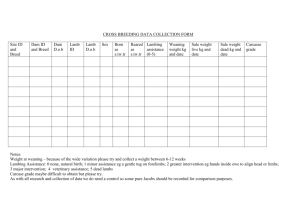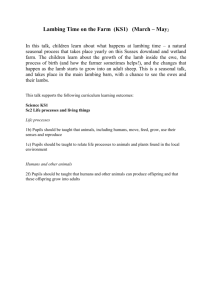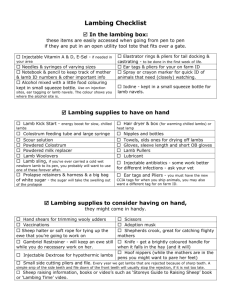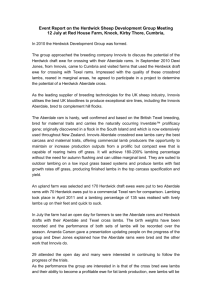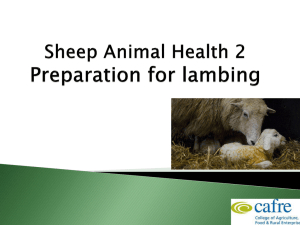A Combunati Lamb Brooder and n0- Ov' aL
advertisement
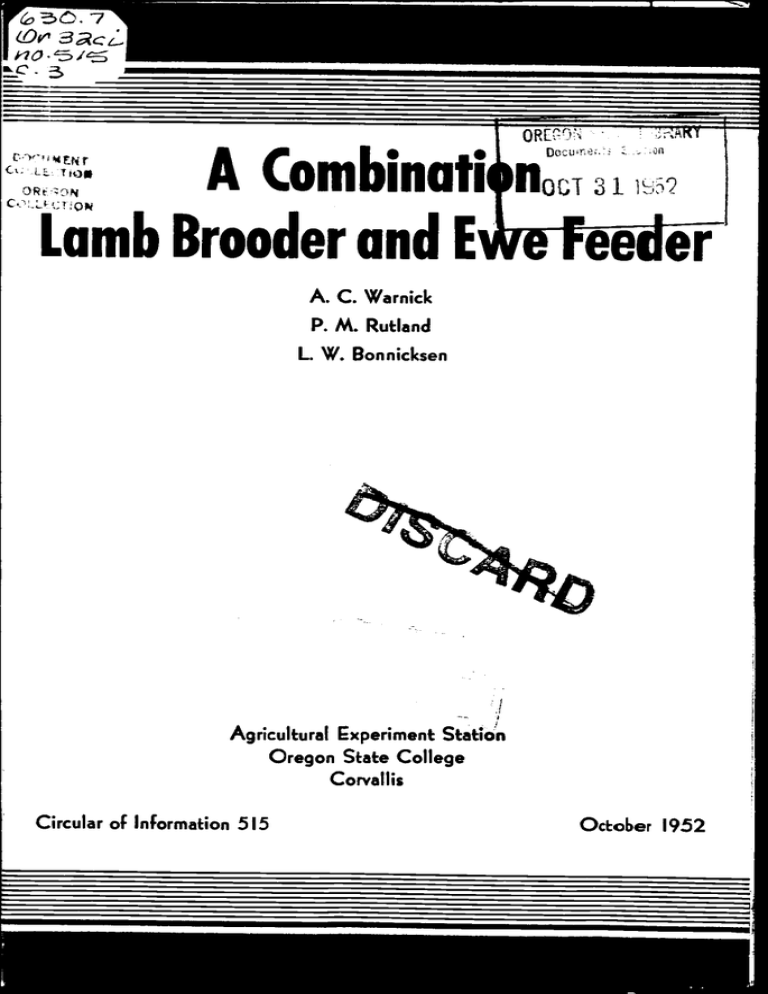
,O. 7 Ov' aL no.sI' 3 I S Ct: T 5 A Combunati OR[O\ Docure n0- on 31 Lamb Brooder and A. C. Warnick P. M. Rutland L. W. Bonnicksen Agrcultural £xperiment Statin Oregon State College Corvallis Circular of Information 515 October 1952 A Combination Lamb Brooder and Ewe Feeder By A. C. WARNICK, assistant animal husbandrna.n, P. M. RUTLAND, shepherd, and L. W. BONNICKSEN, assistant agricultural engineer, Oregon Agricultural Experiment Station Several types of heated lamb brooders are available for sheep but none provide feeding facilities for the ewe in addition to heat for the newborn lamb. The new .conibination unit described in this publication combines the brooder and feeder provisions, is inexpensive and easy to build, is portable and can be adapted to any size operation since it is built in attached sections. The light and heat provided by a 150-watt light bulb in the brooder-feeder combination offers protection for newborn lambs and helps in keeping the lamb dry and warm when it is not nursing the ewe, Figure 1. Because the ewe has access to Figure 1. Brooder lights under the feed trough warm and protect lambs. 2 Figure 2. Several 4-ewe units assembled to save space and labor. the lamb at all times, the number of disowned lambs as a result of separation soon after birth is reduced. The lamb may need help in locating the heat source at first but it soon learns where it can keep warm and dry and stays under the brooder much of the time. The brooder is desirable since it makes earlier lambing possible in areas of critical temperature. Early lambing, in turn, gives possibilities for earlier marketing of lambs in the spring when prices are generally higher compared to later marketed lambs. One unit, as shown in the isometric drawing on page 4, provides space for four ewes with lambs and the units can be combined end to end to make a large functional lambing unit, Figure 2. When the units are placed end to end, each brooder must be plugged in separately to an electrical service outlet which is properly wired to carry the load. The unit is comDact so several can be stored when not in use with a minimum of space. The space on top of the brooder provides space for feeding hay, silage, or grain to the four ewes. Also included is space for a 20-inch by 24-inch water pan, 6 inches deep, placed in the center to provide water for the four ewes. This method of feeding and watering eliminates scattered feed and the use of buckets which are needed for watering from the 4-foot by 4-foot lambing pen. Thus, the ewe and her lambs have more room and more sanitary lambing cxjnditions. The lambing - 3 pen is attached to the brooder-feeder unit with wire or hooks and eyes. Feeding and watering can be done by walking down the feed troughs over the brooder or by entering each individual lambing pen. This unit can be constructed under farm or ranch conditions and makes maximum use of 1-inch lumber and one sheet of 3/8 inch, 2 feet by 8 feet plywood (see Bill of Materials). Plywood gives more protection for electrical equipment from spilled water. Exterior type plywood is preferred because it would give longer life due to its resistance to moisture. Light bulbs are changed easily and the size can be varied, depending upon general weather conditions. Heat lamps cannot be used instead of the regular light bulbs because of directional heat, high cost, and an excessive heat that could injure the lambs. One-i,nch hardware cloth over the light bulbs will prevent much breakage. The electrical wiring can be done by farmers with proper tools and skill; otherwise it would need to be done by a qualified electrician. The pull-chain switch at each light bulb makes it easier to turn individual light bulbs off that are not in use. The unit can be made during slack periods of labor, which results in a saving of money for the operator. The cost of materials for the unit in late 1952 was approximately tl5. This design provides a portable and adaptable unit that can be set up in any sheltered area where there is adequate wiring for the number of light bulbs used. When not in use the units can be stored until next lambing season. The combination lamb brooder-ewe feeder has been used by the Oregon Agricultural Experiment Station throughout the past year and has proved very satisfactory. Bill of Materials Lumber: Hardware: item Number 8 2 6 2 3 3 6 1 - 8 1 1 1 1 1 1 1 1 x x x x x x x x 2 x Number 2 by 1' 4 by 2' 4 by 3' 4 by 8' 6 by 2' 6 by 8' 6" item 4 - 12" x 18" 1" x 1" hardware cloth 4 - 1' x 1' reflecting metal (aluminum preferred) 4 - 8" x 4' heavy canvas Nails 12 by 1' 12 by 8' 2 by 1' l-2x2by2' l-2x2by8' (optional) (optional) 1 - 2' x 8' 3/8" plywood (exterior grade preferred) 4 - Lath Electrical: Number 4 4 4 10' 10' 1 - item Steel junction boxes Porcelain light receptacle (pull chain optional) Light bulbs (size varies with heating requirements) No. 14-2 nonmetallic sheathed cable No. 16-2 rubber-coated extension cord Male plug LAMB BROODER AND EWE FEEDER 2x2 RIPED DIAGONALLY. AS8ESTOS SHEET BETWEEN PLYWOOD AND REFLECTOR. (OPTAL) Ix 4 LATH BATTEN I x I HARDWARE CLOTH FASTENED HEAVY GANVM EXTENDING 6' REFLECTING METAL SHEET PLACED ABOVE BULB. TO 2x2s BELOW PLYWC F- SIDE ELEVATION I NO. 14-2 NON-METALIC SHEATHED CABLE. -- I-O"4 1-0 2-0" SECTiON A-A I I I I I CONNECTING WIRING IS NO. 16-2 RUBBER COATED EXTENSION CORD WITH MALE FITTING, 0 LONG. LIGHT BULB SIZE VAIIES WITH HEATING REQUIREMENTS. PORCELAIN LIGHT RECEPTICAL PULL CHAIN OPTIONAL. I LAMBING PEN I I PLAN LA I I PLYW00D.j I 1x12 ( 2'0" END ELEVATION NOTE: ATTACH FOUR 4x4 LAMB- ING PENS TO EACH OF ThESE UNITS. ISOMETRIC DRAWING
